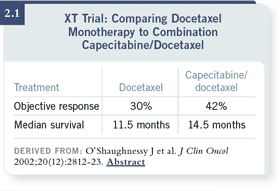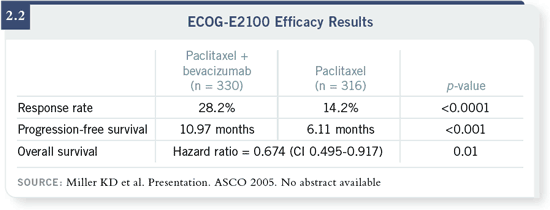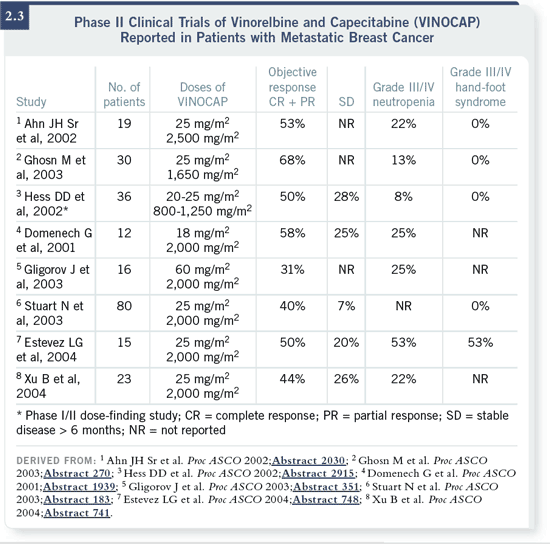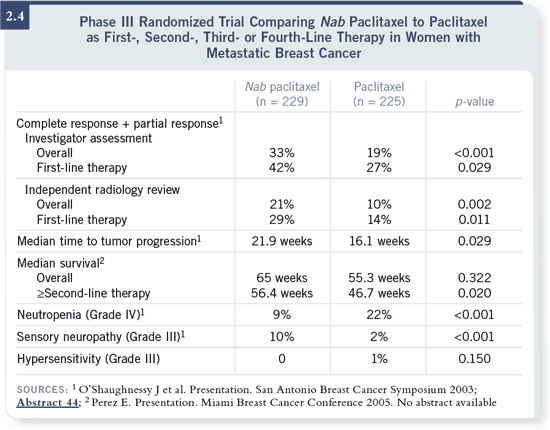| |

Selection of combination regimens for patients with visceral crisis
We now have some very good combinations, and which one to use depends
on what the patient received in the adjuvant setting. If a patient has relapsed
relatively quickly, as many women with visceral crises do, she may have
already been exposed to an anthracycline and a taxane. If a patient has not
been exposed to these agents, a reasonable combination might be docetaxel
with either doxorubicin or epirubicin.
Docetaxel is the single most active drug in breast cancer, and probably one of
the few times I use it early in the treatment of metastatic disease is for patients
with visceral crisis, because we need a quick response or we’re not going to
reach second- or third-line therapy.
 Several combinations now
have a track record in
Phase III trials, including
docetaxel plus capecitabine
(O’Shaughnessy 2002;
[2.1]). Another combination
with perhaps less toxicity is
paclitaxel plus gemcitabine
(Albain 2004). A third
acceptable combination is
paclitaxel plus bevacizumab
(Miller 2005; [2.2]). Each
of these has been shown in
controlled randomized trials to be superior to a comparator, and any of these
would be a reasonable choice. Carboplatin plus paclitaxel is also a reasonable
regimen (Fountzilas 2004).
Several combinations now
have a track record in
Phase III trials, including
docetaxel plus capecitabine
(O’Shaughnessy 2002;
[2.1]). Another combination
with perhaps less toxicity is
paclitaxel plus gemcitabine
(Albain 2004). A third
acceptable combination is
paclitaxel plus bevacizumab
(Miller 2005; [2.2]). Each
of these has been shown in
controlled randomized trials to be superior to a comparator, and any of these
would be a reasonable choice. Carboplatin plus paclitaxel is also a reasonable
regimen (Fountzilas 2004).
Another regimen is vinorelbine plus capecitabine, which has been shown in
Phase II trials to be a very well-tolerated and effective regimen (2.3). It has
a tremendous advantage in that neither agent causes alopecia. A lot of my
patients choose this combination for that reason. Even in the absence of Phase
III data, I believe vinorelbine and capecitabine is probably every bit as good as
any of the other combinations.
— Charles L Vogel, MD


Selection of first-line, single-agent chemotherapy
For the more typical patient who is not in a life-threatening situation, I
discuss single-agent therapy. A lot of these women have received adjuvant
doxorubicin, and alopecia is a very real concern for them. I usually try, in the
single-agent setting, to avoid drugs that cause alopecia. Fortunately, we have
capecitabine, vinorelbine, liposomal encapsulated doxorubicin and gemcitabine, all of which have a very good likelihood of inducing an antitumor response
and a low likelihood of causing alopecia. The oral drug, capecitabine, is an
excellent drug, and we use a lot of it. Many practitioners recommend it for
older women, but we use it for any patient. It doesn’t cause hair loss, and if
you use a dose that doesn’t cause significant toxicity, then the patient is happy
because they are in the doctor’s office less and in charge of their own destiny.
Some people may think of capecitabine as a step down when switching from
hormonal therapy to chemotherapy. It’s one step away from parenteral therapy,
and that’s why we do use a lot of it outside the context of clinical trials.
— Charles L Vogel, MD
Advantages of capecitabine
A chemotherapy agent such as capecitabine, which is effective and doesn’t
cause hair loss, is very appealing to patients with metastatic disease. Today,
I would say hair loss is the number-one issue in terms of side effects. As for
the other side effects associated with chemotherapy that have plagued patients
for the last 25 or 30 years, medications have been developed to offset their
severity, but alopecia is still a problem. In addition, the advantage of taking
an oral medication like capecitabine over having to come in for infusions
improves the patient’s quality of life, particularly in younger women with
active lifestyles.
— Nancy Sokolowski, RNC, OCN
Capecitabine is an enormously effective chemotherapy agent for patients with
breast cancer. It’s a tremendous advantage for us to be able to offer it, because
it’s well tolerated, oral and requires fewer doctor visits. In addition, patients
don’t lose their hair. For patients with metastatic disease, we’re trying to
maintain quality of life. If we thought aggressive combination regimens would
cure these patients, we would use them, but we’ve shown that they do not.
— Richard Zelkowitz, MD
Managing the side effects of capecitabine
Chemotherapy nurses need to educate patients who are just starting
capecitabine about managing side effects. We distribute a lot of pamphlets,
and the patients are alerted to discontinue the medicine and call in at any
sign of hand-foot syndrome. Even if they don’t call right away, they know to
discontinue the medication early on. Most patients don’t tolerate the doses of
capecitabine that were initially recommended, so we’ve modified the dose, and
I have patients on some unusual schedules. Some patients take it for one week
and then are off it for a week, and I have some patients who are on a lower
daily dose, rather than two weeks on and one week off.
— Richard Zelkowitz, MD
I spend a lot of time talking to the patient about the three major toxicities
associated with capecitabine — stomatitis, diarrhea and hand-foot syndrome
— and that is reinforced over and over again by the nurses. I tell patients to
stop the medication as soon as they develop any sores in their mouth or any hint of diarrhea and then to call us. If they notice a little redness on their
hands or feet, they should come in for an examination, but if their hands or
feet are becoming sore, they are to stop the capecitabine and call us. With
prompt attention to these side effects, I can’t remember a single patient that
I haven’t been able to get through a course of capecitabine. I can’t emphasize
enough the critical role of the office oncology nurse to educate these patients.
We have observed a syndrome that could be termed “no pain, no gain,” in
which patients feel that they’ve got to be tough and accept whatever toxicity
occurs, but that’s not what you do with capecitabine. If you support that
approach, you’re going to run into trouble, and the patient may become quite
ill and require hospitalization.
— Charles L Vogel, MD
Selecting a taxane
I use taxanes in the metastatic setting on a weekly schedule. My choice
between docetaxel and paclitaxel is determined basically by toxicity, convenience
and premedication issues. I believe that once the reimbursement issues
concerning nanoparticle albumin-bound (nab) paclitaxel are resolved, nab
paclitaxel will make all the sense in the world. The elimination of the need for
premedication and the better toxicity profile make it enormously appealing.
— Richard Zelkowitz, MD
Nab paclitaxel
This is a very interesting concept and a nice bit of engineering. Basically,
paclitaxel is put into albumin packets. This makes use of the body’s own
proteins, which makes it possible to administer the paclitaxel without the
use of solvents. We are even receiving hints that nab paclitaxel may actually
be a little better than paclitaxel in terms of efficacy (O’Shaughnessy 2003;
Perez 2005; [2.4]). The drug is new and we’re just getting a feel for it. We’re
impressed with what we’ve seen so far. We’ve been largely using nab paclitaxel
on a weekly schedule. We use a lot of carboplatin and paclitaxel on a weekly
basis for three out of four weeks, and we’ve been substituting nab paclitaxel in
that combination. However, that is adjusted by patient preference. If a patient
would like to come in more intermittently, then giving it every three weeks is
perfectly fine.
— Charles L Vogel, MD
Advantages in the administration of nab paclitaxel
I see specific problems with premedication, and I believe the steroids are a real
issue. We’re seeing a lot of late sequelae from chemotherapy, such as arthralgias,
which one well-known, more senior oncologist has termed the rheumatism
of chemotherapy, and I believe part of that can be attributed to all the
steroids we use. We use lots of steroids with our antiemetics and with the
taxanes. Nab paclitaxel will allow us to not have to do that — probably with
better efficacy (2.4).
— Richard Zelkowitz, MD
The ability to use nab paclitaxel without a solvent such as Cremophor® decreases allergic phenomena and some other toxicities. It also enables one
to administer the drug without much premedication. Avoiding steroids is
beneficial because agents such as dexamethasone have a broad array of their
own symptoms. One of the biggest complaints is insomnia — these women
wake up and want to wash the windows at four o’clock in the morning.
Weight gain is another problem. Even just three days of dexamethasone, used
as a premedication with docetaxel, can begin to cause cushingoid changes,
and patients are troubled by these body-shape changes. In addition, we see
problems with ulcers, cataracts, hypertension and the precipitation of diabetes.
The shorter infusion time with nab paclitaxel can be financially advantageous
in an oncology office, as one can accommodate more patients. Also, it’s more
convenient for patients, which is beneficial; they can get on with the business
of living their lives.
— Charles L Vogel, MD
I do see an advantage to avoiding premedication. I believe the general public
is antimedication, so any way in which we can keep treatment simple is
appealing to the consumer. Also, the infusion time for nab paclitaxel is
shorter, and I see that as a positive difference. Patients have very busy schedules,
and if they can come to us and spend one hour instead of three hours,
it’s going to make a major difference. I think it will integrate better in their
pattern of living.
— Nancy Sokolowski, RNC, OCN

|
|

